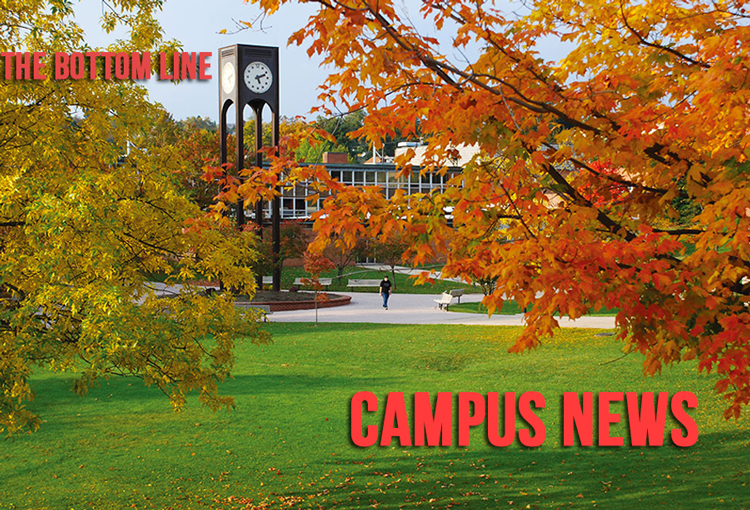Sustainability: The Impact of the Individual
Throughout the month of October, the students in Tracy Edwards’ Intro to Sustainability Studies course were asked to complete various sustainability-related challenges. Our participation was meant to help bring awareness to the healthy development of our planet and those who inhabit it.
As I sat through the first few classes, Tracy Edwards gradually informed us that this wouldn’t be a traditional class environment. This course was about engagement and making sure we as students are getting out and getting involved.
I was slightly confused. I remember asking myself early on: where are the homework assignments, discussion boards, or exams? The only physical paper I remember getting handed was an explanation of this green-challenge-thing, the starting date of which was fast approaching. It seemed like an interesting and beneficial concept, both for the environment and my academic record. As the term went on, my preconceived notions towards sustainability slowly unraveled. I realized that it’s a lot more than solar panels and recycling, it’s hard work on many different cultural, economic, and political levels.
Project Green Challenge takes place throughout the entire month of October, on a website hosted by the organization Turning Green. Each day, a sustainability-related prompt is posted that participants are expected to complete by midnight. The challenges range in degree of difficulty and amount of points awarded: green (20), greener (40), and greenest (60).
An example of a green level challenge would be day seven’s “Body” prompt, which asks participants to watch a video on the story of cosmetics, write down what they learned, and how it might change their daily routine. The completion of this would earn a participant 20 points.
FSU senior Bryer Saville actually went above and beyond for the “Body” designated day and ended up winning the greener challenge. He did so by creating a diagram that showcased his planned change in toothpaste brand in favor of more organic and environmentally-friendly ingredients.
 It was the level of participation from students like Bryer that helped FSU finish with a collective point total of 4660, getting our school’s name within the top fifteen on PGC’s school leaderboard. This is where Turning Green congratulates the schools that earned the highest number of points throughout the month.
It was the level of participation from students like Bryer that helped FSU finish with a collective point total of 4660, getting our school’s name within the top fifteen on PGC’s school leaderboard. This is where Turning Green congratulates the schools that earned the highest number of points throughout the month.
Each student was asked to reach 240 points during our period of involvement, which would start October 1st and end October 30th. These dates are followed by students around the world, something I see as one of PGC’s main beneficial aspects. Not only are you learning about different sustainability efforts, but you get to see the creative achievements of peers from countries that are actually facing the obstacles we’re learning about, like Nigeria, Iran, and India.
Reaching a point total of 240 may not sound particularly difficult, but when you consider that you aren’t allowed to know about the challenges beforehand, and only have a limited amount of time to submit answers, it really does become a challenge. The number 240 wasn’t plucked out of thin air though, Edwards picked this amount to create convenience, but only as it related to enthusiasm.
“If a student was motivated to, they could reach their required point total in two days.” Edwards said.
When I was first introduced to PGC, I assumed the themes and goals would be related to stuff like clean energy and recycling, things most people associate with keeping the planet alive. As it turns out, there are many goals that some might not even think to relate to sustainability but as they get introduced, it’s hard to envision a functioning planet or society without them.
The United Nations General Assembly created the seventeen Sustainable Development Goals in 2015. This list of objectives clarifies that helping the environment relies on the development of society. These goals have a symbiotic relationship. It’s not just about clean water or clean energy, although those are also important pursuits. Making sure that emerging generations have quality education and sustainable infrastructure matters just as much.
Although it might all seem overwhelming, there’s a very clear starting point: the individual. Just focusing on how one person can make an impact, opens many other doors, like those within PGC. Increased involvement means increased opportunities to share what people are doing, what they’ve learned, and what sustainability means to them in comparison to those around the world. If recycling or solar panels aren’t someone’s thing, that’s okay. There’s something every career field can contribute to sustainability, from fashion to architecture to economics.
If someone still has doubts about getting involved, I get it, it seems like increased work for little reward, but there’s always a chance for someone to see what their impact can be. A lot of us say to ourselves that we are only one person, and therefore question if our potential impact justifies the effort we put in. Yes, learning to put used plastic in the right place is part of the journey, but so is unlearning complacency, and realizing that the individual matters as much as the whole.



